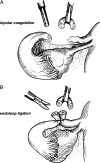Randomized comparison between two microlaparoscopic techniques for partial salpingectomy
- PMID: 15791966
- PMCID: PMC3015551
Randomized comparison between two microlaparoscopic techniques for partial salpingectomy
Abstract
Objective: We compared 2 techniques for performing a partial salpingectomy by using microlaparoscopy and either bipolar coagulation or loop ligation.
Methods: A 3-mm transumbilical laparoscope with secondary midline port sites midway and suprapubically was used to perform a partial salpingectomy in 109 women desiring permanent sterilization. Each patient was randomly assigned to undergo a tubal resection either after Pomeroy ligation (n= 54) or after bipolar coagulation with Kleppinger forceps (n=55). Postoperative pain, as assessed using a 10-point visual analog scale, was the primary comparison endpoint.
Results: No technical difficulties with either technique required conversion to a minilaparotomy. The mean time to remove both tubal segments was not different between techniques (7 minutes, 21 seconds; range, 4 minutes, 25 seconds to 15 minutes, 43 seconds). Each segment (mean, 1.6 cm; range, 0.8 to 3.5 cm) was confirmed in the operating room, then histologically. Postoperative pain at 6 hours was scored similarly (median, ligation 4.6, coagulation 4.0 of 10). Outpatient recovery was the same, unless pelvic pain required overnight observation (ligation, 4 patients; coagulation, 2 patients).
Conclusion: Partial salpingectomy, using microlaparoscopy with either bipolar coagulation or loop ligation, was performed with comparable ease, confirmation of the removed tube, and similar postoperative discomfort.
Figures


Similar articles
-
Microlaparoscopic technique for partial salpingectomy using bipolar electrocoagulation.J Reprod Med. 2001 Jul;46(7):632-6. J Reprod Med. 2001. PMID: 11499182
-
A microlaparoscopic technique for Pomeroy tubal ligation.Obstet Gynecol. 1997 Aug;90(2):249-51. doi: 10.1016/S0029-7844(97)00234-2. Obstet Gynecol. 1997. PMID: 9241303
-
Pomeroy tubal ligation by laparoscopy and minilaparotomy.Adv Contracept. 1994 Jun;10(2):151-5. doi: 10.1007/BF01978108. Adv Contracept. 1994. PMID: 7942262 Clinical Trial.
-
Laparoscopic tubal sterilization. Methods, effectiveness, and sequelae.Obstet Gynecol Clin North Am. 1999 Mar;26(1):83-97. doi: 10.1016/s0889-8545(05)70059-0. Obstet Gynecol Clin North Am. 1999. PMID: 10083931 Review.
-
Female sterilization. Evidence.Obstet Gynecol Clin North Am. 2000 Dec;27(4):859-99. doi: 10.1016/s0889-8545(05)70175-3. Obstet Gynecol Clin North Am. 2000. PMID: 11091991 Review.
Cited by
-
Tubal Ligation Induces Quiescence in the Epithelia of the Fallopian Tube Fimbria.Reprod Sci. 2015 Oct;22(10):1262-71. doi: 10.1177/1933719115574345. Epub 2015 Mar 2. Reprod Sci. 2015. PMID: 25736327 Free PMC article.
-
Microlaparoscopic pyloromyotomy in children: initial experiences with a new technique.Surg Endosc. 2011 Jan;25(1):266-70. doi: 10.1007/s00464-010-1172-1. Epub 2010 Jun 18. Surg Endosc. 2011. PMID: 20559660 Clinical Trial.
-
Techniques for the interruption of tubal patency for female sterilisation.Cochrane Database Syst Rev. 2016 Aug 5;2016(8):CD003034. doi: 10.1002/14651858.CD003034.pub4. Cochrane Database Syst Rev. 2016. PMID: 27494193 Free PMC article.
References
-
- Sterilization. Am Coll Obstet Gynecol Tech Bull. 1996;222: 1–3
-
- Peterson HB, Zhisen X, Hughes JM, Wilcox LS, Taylor LR, Trussell T. The risk of pregnancy after tubal sterilization findings from the U.S. Collaborative Review of Sterilization. Am J Obstet Gynecol. 1996;194:1161–1170 - PubMed
-
- Murray J, Hibbert ML, Heth SR, Letterie GS. A technique for laparoscopic Pomeroy tubal ligation with endoloop sutures. Obstet Gynecol. 1992;80:1053–1055 - PubMed
-
- Siegle JC, Cartmell LW, Rayburn WF. Microlaparoscopic technique for partial salpingectomy using bipolar electrocoagulation. J Reprod Med. 2001;46:632–636 - PubMed
-
- Kleppinger RK. Laparoscopy tubal sterilization. In: Garcia CR, Mikuata JJ, Rosenblum NJ, eds. Current Therapy in Surgical Gynecology. Philadelphia, PA: BC Decker; 1987:80–86
Publication types
MeSH terms
LinkOut - more resources
Full Text Sources
Medical
